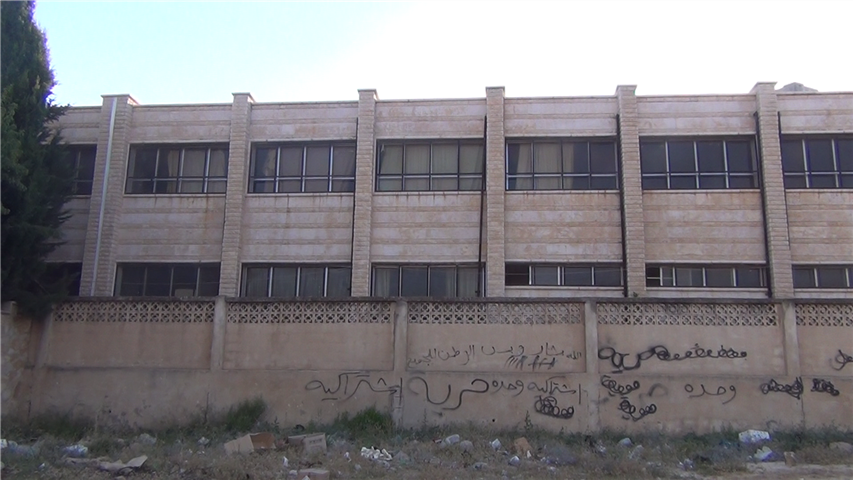Messyaf: Caught Between Regime and Opposition

Maamarji
In the past few months, security checkpoints have proliferated on the roads between villages surrounding the city of Messyaf, in the western Hama governorate.
At the same time, the forces manning these checkpoints behave relatively courteously towards travellers, especially in the daytime. This seems to be a response to a number of violent incidents.
Suspected opposition supporters, including Sunni Muslims from Houla, scene of a massacre in May in which over 100 civilians were killed by a pro-regime militia, are not accorded the same treatment.
Muhannad, a 28-year-old Ismaili Muslim from Mesyaff but living in Aleppo, says checkpoint personnel now rarely discriminate between Sunni, Alawite and Ismaili opposition activists.
“Before demonstrations took place in Messyaf [in May], we used to feel ashamed because pro-regime Sunnis were treated worse than Alawite or Ismaili opposition supporters,” he said. “But after the funeral processions of Ismail Haidar and Mahmoud Shihawi, we too started suffering at checkpoints – the security forces began insulting everyone from Messyaf.”
Opposition activist Ismail Haidar, son of the current Minister of National Reconciliation Affairs Ali Haidar, was assassinated on May 2. The regime and opposition have accused each other of killing him.
Mahmoud Shihawi was a Syrian army conscript who was arrested for supporting the opposition, and died in custody in April 2012, allegedly after being tortured.
Like members of other religious minorities, the Ismailis are frequently branded as pro-regime. But Muhannad, an Ismaili, participated in the protests at the University of Aleppo in May. When he returned to Messyaf afterwards, he was abused by servicemen at a checkpoint outside the city.
“I felt proud that day. I told myself, ‘Thank God we have become part of the Syrian popular uprising.’ Being insulted by the regime’s security forces is a source of pride for me and every other revolutionary in Messyaf,” Muhannad said.
Messyaf is a city of under 100,000 that sits on the eastern slopes of the coastal mountain range. The city’s population is made up of Sunnis, Ismailis and some Alawites. There are around 130 villages in the surrounding area, mainly inhabited by Alawites and Christians, except for the Houla valley, which has a Sunni majority.
Since the May 25 massacre, public transport and private vehicles can only enter Houla with the permission of the security forces and pro-regime militias. Once the area joined the uprising, the road from Messyaf to Homs – which cuts though Houla’s golden wheat fields – was closed, and the only route now available goes through mountains and forests.
In Alawite-majority villages like Al-Qabu and Miramin near Houla, there are posters everywhere showing pro-regime fighters who have been killed; the texts praise them as defenders of the homeland. There are also many posters of President Bashar al-Assad, since regime supporters are in control here. For anyone coming from Aleppo or Damascus, these villages look like havens for the pro-regime “shabbiha”, just as those two cities used to seem to outsiders less than a year ago.
The regime established its control by force, however. Of all regime supporters, the Alawites know best how violent the government is.
Many Alawites living in rural areas around Messyaf see the Syrian crisis as a threat to their existence, and are less concerned about the fate of the regime than they are about their own.
The regime has given these people preferential treatment for getting government employment and laying claim to publicly-owned land, and this has antagonised Messyaf’s urban population. For their part, people from the countryside think they are historically the victims of injustice, and believe urban-dwellers have always looked down on them. Now they fear that if the regime falls, they will lose the privileges they have gained.
Some people from the countryside have nevertheless joined the revolution.
Ali, an Alawite merchant from a village outside Messyaf, provides financial support to opposition activists in the city of Hama. He feels uncomfortable about being tagged with a particular sectarian identity.
“The Syrian revolution calls for equality before the law for all citizens, irrespective of religious, ethnic or political affiliation. It is belonging to the homeland that should bring us together,” says Ali. “This is why I don’t think it’s necessary to say that I’m participating in the revolution as an Alawite. I am taking part as a Syrian.”
Sectarian incidents rarely occurred in this area before the revolution. These days, both regime and opposition are fuelling sectarian tensions.
“The regime has provoked people in the area in all sorts of ways, but some opposition groups have probably been more successful in inciting sectarianism,” said Moataz, a young Sunni opposition activist, describing how some of his peers behave towards members of religious minorities.
Activists here complain that pro-opposition media ignore the deaths of combatants on the regime side, and that they deny that opposition fighters are responsible for some sectarian killings. What is worse, they say, is the sectarian narrative of Salafi TV channels like Wissal and Safa.
Others accuse Al-Jazeera and Al- Arabiya television of ignoring peaceful protests in Messyaf.
“We’ve never had problems with Orient TV because it takes a patriotic Syrian line,” Ziad Ibrahim, a media activist from Messyaf, said. “The day Ismail Haidar was killed, Al-Jazeera and Al-Arabiya asked us to film a report about it. But over time, we began to sense that the two channels were steering clear of us. I know Messyaf hasn’t staged flashy protests, but covering [peaceful protests] doesn’t fit with these channels’ policy.”
[Some names have been changed for reasons of security.]
Maamarji is the pseudonum of a Syrian blogger.
